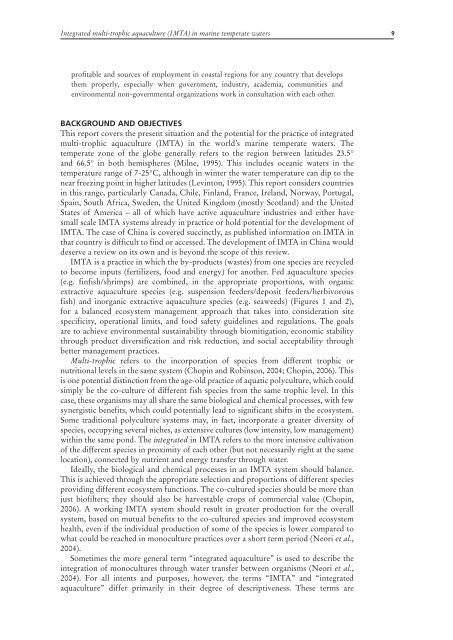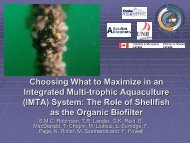Integrated multi-trophic aquaculture (IMTA) in marine temperate waters
Integrated multi-trophic aquaculture (IMTA) in marine temperate waters
Integrated multi-trophic aquaculture (IMTA) in marine temperate waters
You also want an ePaper? Increase the reach of your titles
YUMPU automatically turns print PDFs into web optimized ePapers that Google loves.
<strong>Integrated</strong> <strong>multi</strong>-<strong>trophic</strong> <strong>aquaculture</strong> (<strong>IMTA</strong>) <strong>in</strong> mar<strong>in</strong>e <strong>temperate</strong> <strong>waters</strong> 9<br />
profitable and sources of employment <strong>in</strong> coastal regions for any country that develops<br />
them properly, especially when government, <strong>in</strong>dustry, academia, communities and<br />
environmental non-governmental organizations work <strong>in</strong> consultation with each other.<br />
BACKGROUND AND OBJECTIVES<br />
This report covers the present situation and the potential for the practice of <strong>in</strong>tegrated<br />
<strong>multi</strong>-<strong>trophic</strong> <strong>aquaculture</strong> (<strong>IMTA</strong>) <strong>in</strong> the world’s mar<strong>in</strong>e <strong>temperate</strong> <strong>waters</strong>. The<br />
<strong>temperate</strong> zone of the globe generally refers to the region between latitudes 23.5°<br />
and 66.5° <strong>in</strong> both hemispheres (Milne, 1995). This <strong>in</strong>cludes oceanic <strong>waters</strong> <strong>in</strong> the<br />
temperature range of 7-25°C, although <strong>in</strong> w<strong>in</strong>ter the water temperature can dip to the<br />
near freez<strong>in</strong>g po<strong>in</strong>t <strong>in</strong> higher latitudes (Lev<strong>in</strong>ton, 1995). This report considers countries<br />
<strong>in</strong> this range, particularly Canada, Chile, F<strong>in</strong>land, France, Ireland, Norway, Portugal,<br />
Spa<strong>in</strong>, South Africa, Sweden, the United K<strong>in</strong>gdom (mostly Scotland) and the United<br />
States of America – all of which have active <strong>aquaculture</strong> <strong>in</strong>dustries and either have<br />
small scale <strong>IMTA</strong> systems already <strong>in</strong> practice or hold potential for the development of<br />
<strong>IMTA</strong>. The case of Ch<strong>in</strong>a is covered succ<strong>in</strong>ctly, as published <strong>in</strong>formation on <strong>IMTA</strong> <strong>in</strong><br />
that country is difficult to f<strong>in</strong>d or accessed. The development of <strong>IMTA</strong> <strong>in</strong> Ch<strong>in</strong>a would<br />
deserve a review on its own and is beyond the scope of this review.<br />
<strong>IMTA</strong> is a practice <strong>in</strong> which the by-products (wastes) from one species are recycled<br />
to become <strong>in</strong>puts (fertilizers, food and energy) for another. Fed <strong>aquaculture</strong> species<br />
(e.g. f<strong>in</strong>fish/shrimps) are comb<strong>in</strong>ed, <strong>in</strong> the appropriate proportions, with organic<br />
extractive <strong>aquaculture</strong> species (e.g. suspension feeders/deposit feeders/herbivorous<br />
fish) and <strong>in</strong>organic extractive <strong>aquaculture</strong> species (e.g. seaweeds) (Figures 1 and 2),<br />
for a balanced ecosystem management approach that takes <strong>in</strong>to consideration site<br />
specificity, operational limits, and food safety guidel<strong>in</strong>es and regulations. The goals<br />
are to achieve environmental susta<strong>in</strong>ability through biomitigation, economic stability<br />
through product diversification and risk reduction, and social acceptability through<br />
better management practices.<br />
Multi-<strong>trophic</strong> refers to the <strong>in</strong>corporation of species from different <strong>trophic</strong> or<br />
nutritional levels <strong>in</strong> the same system (Chop<strong>in</strong> and Rob<strong>in</strong>son, 2004; Chop<strong>in</strong>, 2006). This<br />
is one potential dist<strong>in</strong>ction from the age-old practice of aquatic polyculture, which could<br />
simply be the co-culture of different fish species from the same <strong>trophic</strong> level. In this<br />
case, these organisms may all share the same biological and chemical processes, with few<br />
synergistic benefits, which could potentially lead to significant shifts <strong>in</strong> the ecosystem.<br />
Some traditional polyculture systems may, <strong>in</strong> fact, <strong>in</strong>corporate a greater diversity of<br />
species, occupy<strong>in</strong>g several niches, as extensive cultures (low <strong>in</strong>tensity, low management)<br />
with<strong>in</strong> the same pond. The <strong>in</strong>tegrated <strong>in</strong> <strong>IMTA</strong> refers to the more <strong>in</strong>tensive cultivation<br />
of the different species <strong>in</strong> proximity of each other (but not necessarily right at the same<br />
location), connected by nutrient and energy transfer through water.<br />
Ideally, the biological and chemical processes <strong>in</strong> an <strong>IMTA</strong> system should balance.<br />
This is achieved through the appropriate selection and proportions of different species<br />
provid<strong>in</strong>g different ecosystem functions. The co-cultured species should be more than<br />
just biofilters; they should also be harvestable crops of commercial value (Chop<strong>in</strong>,<br />
2006). A work<strong>in</strong>g <strong>IMTA</strong> system should result <strong>in</strong> greater production for the overall<br />
system, based on mutual benefits to the co-cultured species and improved ecosystem<br />
health, even if the <strong>in</strong>dividual production of some of the species is lower compared to<br />
what could be reached <strong>in</strong> monoculture practices over a short term period (Neori et al.,<br />
2004).<br />
Sometimes the more general term “<strong>in</strong>tegrated <strong>aquaculture</strong>” is used to describe the<br />
<strong>in</strong>tegration of monocultures through water transfer between organisms (Neori et al.,<br />
2004). For all <strong>in</strong>tents and purposes, however, the terms “<strong>IMTA</strong>” and “<strong>in</strong>tegrated<br />
<strong>aquaculture</strong>” differ primarily <strong>in</strong> their degree of descriptiveness. These terms are



